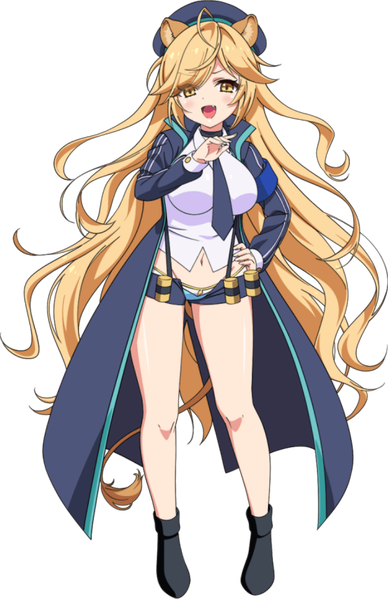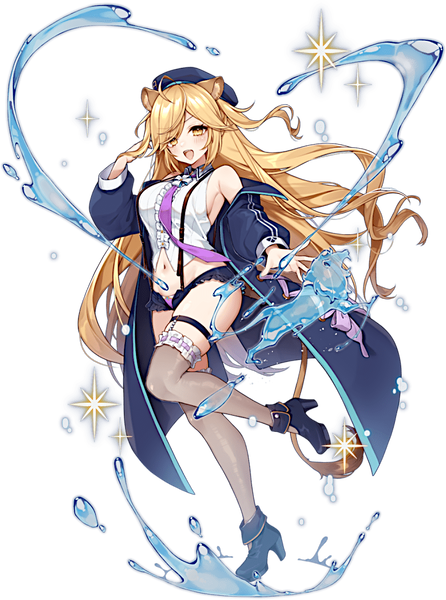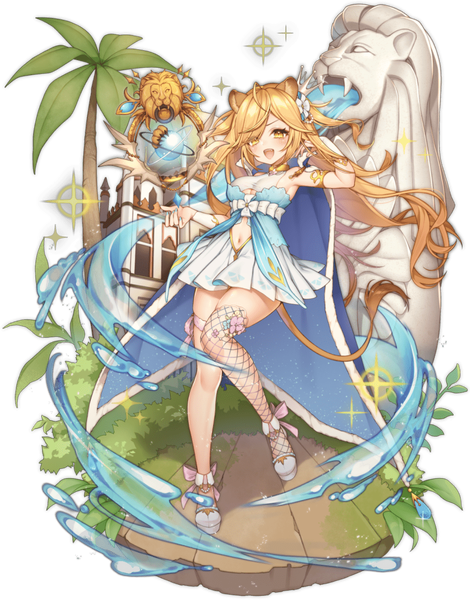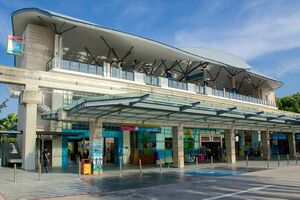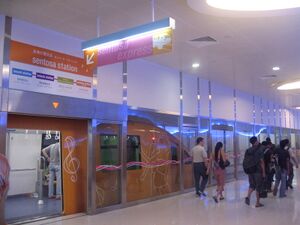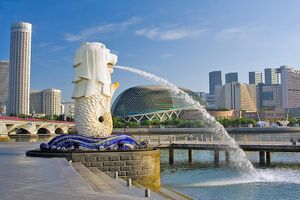Sentosa
| Sentosa | |||||
|---|---|---|---|---|---|
| Japanese Name | セントーサ | ||||
| Weapon | |||||
| Race | Beast | ||||
| Nationality | |||||
| Birthday | January 15 | ||||
| Constellation | Capricorn | ||||
| Talents | Handling magical artifacts | ||||
| Likes | Expensive jewelry and dresses typical of aristocrats, Lions | ||||
| Dislikes | Filth, Vulgarity, Things that are too hot | ||||
| Strengths | Strong vitality, Highly capable on her job | ||||
| Weaknesses | Easily worked up (Kiasu), Crybaby | ||||
| Hobbies | Being absorbed in self-indulgent pleasures | ||||
Hmmhmm, Yours Truly is the daughter of an extremely wealthy man who made his fortune in tourism and of the entertainment district. Daddy's member of a noble family holding a seat in the Summit of the Underwater Temple also. That's why Yours Truly is such a big deal, you see. Oh, and don't be shocked by these ears and tail of mine - My mommy's from Nishiki.
Layers
| Icon | Title | Release Date | Where to Obtain |
|---|---|---|---|
| [Classy Lion] Sentosa | 2021 October 23 | [Altar of Judgement - Meat Fairy] Event Reward | |
| [Noble Roar] Sentosa | 2022 October 24 | [Allies of Justices and Villains of Evil] Limited Gacha | |
| [The Golden Sheltered Lady] Sentosa | 2021 October 23 | [The Bizarre Lady and the Immovable Sorceress] Limited Gacha |
Owned Skills
Trivia
- Sentosa's birthday is the opening date of Sentosa Express in 2007, connecting Singapore to Sentosa Island.
- Sentosa's beast motif is the (mer)lion. The name Singapore comes from the Malay words "Singa" for lion and "Pura" for city.
- Sentosa's back story is a reference to Singapore's tourism industry and its success as a developed Southeast Asian country despite being a small country with no natural resources.
- Sentosa is able to breath underwater thanks to her father's Mermaid Blood, while also inheriting her mother's Beast Blood, enabling Nishikese sorcery. These two represents her merlion theme. Her mother being Nishikese also references the Hitachi Asia Company that constructed the Sentosa Express line.
- The buildings in the background of [The Golden Sheltered Lady] are the Masjid Sultan (left) in Kampong Glam, and the Merlion (right), iconic symbol of Singapore.
- [The Golden Sheltered Lady] Special Skill animation is a reference to the "Circle of Life" opening scene in Disney's "The Lion King" (1994).
- Sentosa's low tolerance of agitation is a parody of Singapore's "kiasu" attitude. Kiasu (惊输; 驚輸) is a Hokkien word that denotes a "grasping, selfish attitude" that arises from fear of missing out. It is commonly used in Singapore, where a survey in 2015 ranked being kiasu as one of the top 10 Singaporean cultural values, and the word has been introduced into the English language by speakers of colloquial Singaporean English.
- Jeran is a rival of Sentosa, a reference to the friendly rivalry between netizens of Malaysia and Singapore. Ironically, Taman Sentosa is also a residential area inside the Jerantut district.
Counterpart
The Sentosa Express is a monorail line connecting Sentosa island to HarbourFront on the Singapore mainland. It was built at a cost of S$140 million to replace the previous Sentosa Monorail. Development began in June 2003 and construction works were completed in December 2006. The fully elevated 2.1-kilometre (1.3-mile; per direction) two-way line (4.3-km total track length) opened on 15 January 2007. The monorail system, privately owned and operated by Sentosa Development Corporation, can move up to 4,000 passengers per hour per direction.
In June 2002, the Sentosa Development Corporation (SDC) awarded a S$78 million (US$43.56 million) contract to Japanese subsidiary Hitachi Asia to build the Sentosa Express, which was part of a ten-year redevelopment plan for Sentosa, an offshore island south of the Singapore main island dedicated to tourism. It was to replace the Sentosa Monorail which had been in operation since 1982, with the previous monorail planned for demolition by 2005. Unlike its predecessor which ran in a loop around the island, the Sentosa Express was planned to cross the sea and interchange with the North East Line on the mainland, with three stations on Sentosa itself, making up a total of four stations.
S$26 million was spent on the elevated stations and the depot next to Beach station. VivoCity station is the only station of the line on the mainland; the rest are on Sentosa. It is also the only one with full-height platform screen doors and a bay platform using the Spanish solution. The other stations on Sentosa island are not air-conditioned and are the first train stations in the country to utilise half height platform screen doors. Like the Mass Rapid Transit, stations have bi-directional escalators and a lift to take passengers from the station concourse to the platforms, except VivoCity station which has both on the same level within VivoCity on the mainland.
The Sentosa Express is the first system to use Hitachi Rail's small-type, straddle–beam monorail with a capacity of about 184 passengers per train. With a total of seven two-car, 25-metre-long trains of different colours each—namely green, orange, blue, purple, pink, red and yellow; the pink and red trains were added to the original fleet of four on 1 December 2009; the yellow train was added on 24 November 2017. In 2015, the orange train was painted into a multi-coloured livery train. In addition, there are 2 other yellow maintenance trains. Wikipedia
The Merlion is the official mascot of Singapore. It is depicted as a mythical creature with the head of a lion and the body of a fish. Being of prominent symbolic nature to Singapore and Singaporeans in general, it is widely used to represent both the city state and its people in sports teams, advertising, branding, tourism and as a national personification.
The Merlion was first used in Singapore as the logo for the tourism board. Its name combines "mer", meaning the sea, and "lion". The fish body represents Singapore's origin as a fishing village when it was called Temasek, which means "sea town" in Javanese. The lion head represents Singapore's original name—Singapura—meaning "lion city" or "kota singa".
The symbol was designed by Alec Fraser-Brunner, a member of the Souvenir Committee and curator of the Van Kleef Aquarium, for the logo of the Singapore Tourism Board (STB) in use from 26 March, 1964 to 1997 and has been its trademarked symbol since 20 July 1966. Although the STB changed their logo in 1997, the STB Act continues to protect the Merlion symbol. Approval must be received from STB before it can be used. The Merlion frequently appears on STB-approved souvenirs. Wikipedia
Map
Gallery
- Pages using Tabber parser tag
- Pages using DynamicPageList3 parser tag
- Weapon Artifact
- Beast
- Flamarine
- Capricorn
- Element Cut
- Element Fire
- Element Light
- Element Water
- Train Knights
- Singapore

